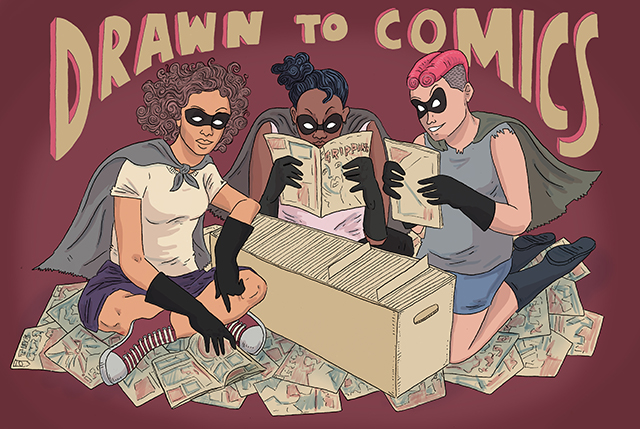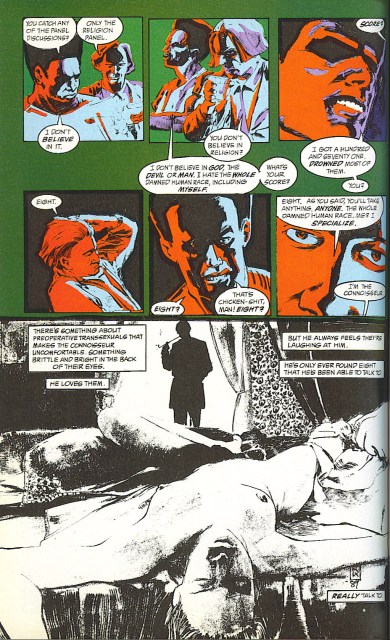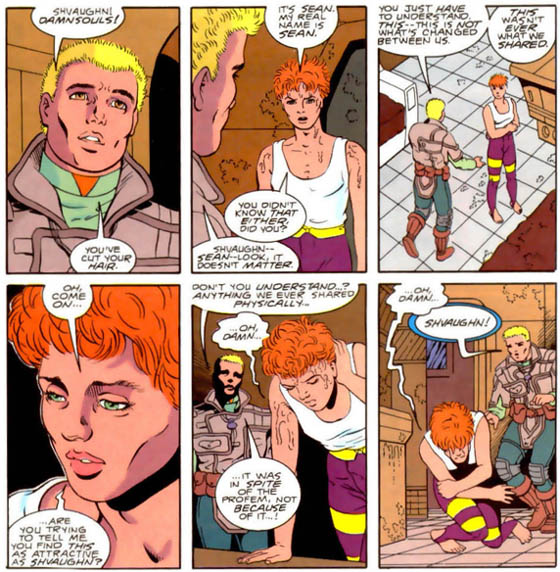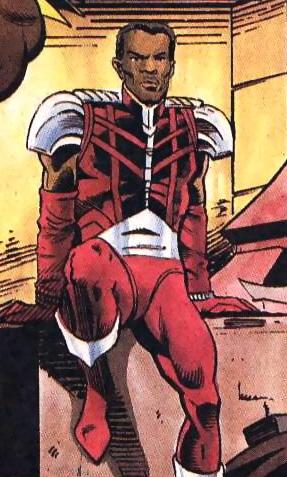
by rory midhani
It’s Trans Awareness Week, the week leading up to Trans Day of Remembrance on November 20th. When we say that Autostraddle is website primarily for queer women, we want to be 100% clear that that includes queer trans women and that it’s important to honor trans women year-round, not just in obituaries. So all week long we’re going to be spotlighting articles by and about trans women, with a special focus on trans women of color. We hope you’ll love reading everything as much as we’ve loved writing and editing it.
I’ve been reading comics ever since I was in elementary school, when I would go to the public library and run upstairs to the comic section and check out whatever graphic novels they had, even if I had read them a dozen times before. But it wasn’t until I was a teenager that I saw my first trans character in a comic book. Like many people, my first experience with a trans comic character was in Neil Gaiman’s Sandman. I remember when I was in high school opening up Volume 2, titled The Doll’s House, and reading issue #14, Collectors. This issue focuses on a serial killer’s convention and predictably features some extremely disturbing content. The thing that stuck in my mind, though, is one panel where we see a killer standing over a dead trans woman with narration that says “There’s something about preoperative transsexuals that makes The Connoisseur uncomfortable. Something brittle and bright in the back of their eyes. He loves them. But he always feels they’re laughing at him. He’s only ever found eight that he’s been able to talk to.” This was my first time seeing someone like me in a comic book. It made me terrified for my future.

From Sandman #14.
One of the big selling points of comic books is that they give us heroes to look up to and want to be like. They show us possibilities. They show us dreams and wishes. Not being able to see yourself in those dreams, wishes and possibilities can really have an effect on you, especially if you’re a younger reader. When readers are told that none of the heroes look like them, it can seem like it’s impossible to be a hero. That’s why representation is important. It allows us to see a brighter future for ourselves and to set out for that future. For trans readers, that representation has been almost nonexistent until recent years.
The Era of Not-Quite-Trans Characters (1940-?)
Unfortunately, transgender people are a group that was so marginalized in comics that the only characters trans people could see ourselves in were shapeshifters, aliens and victims of magic spells or science fiction body swaps. While trans characters were scant for most of the history of comic books, these kinds of characters were actually pretty popular, going as far back as DC Comics’ Golden Age. So while these characters are not quite trans, they still served an important function in giving trans readers some semblance of representation in their comics.

The Ultra-Humanite in Action Comics #20 with art by Joe Shuster.
One of the earliest examples of a not-quite-trans recurring character took place in Action Comics #20 from 1940. The Superman villain, Ultra-Humanite (a super genius similar to Lex Luther), has seemingly been killed. However, we learn that he had kidnapped a famous actress, Dolores Winters, and placed “his mighty brain in her young vital body.” As soon as Action Comics #22 this version of the Ultra-Humanite was gone and later instead of putting his mind in the body of a woman, the character would transfer his consciousness into the body of an albino ape. However, during the events of Infinite Crisis, a universe-wide crossover event in the late 2000’s, and in the 2006-2007 Lightning Saga crossover event, the Ultra-Humanite’s time as Dolores (now spelled Deloris) Winters is revisited.

Sir Tristan in Camelot 3000 with art by Brian Bolland.
The next notable examples appear in the 1980s when DC Comics published Mike W. Barr and Brian Bolland’s sci-fi/fantasy series Camelot 3000. In this story King Arthur and his knights of The Round Table are reincarnated in the year 3000 in order to fight off Morgan le Fay and an alien invasion. One of the knights, Sir Tristan, is reincarnated as a woman. Tristan spends much of the comic trying to figure out a way to be turned back into a man, but in the end accepts this new body and role, even ending up with Isolde, Tristan’s lover throughout time. Stories like this showed the lack of awareness of real life trans people that comics had. Sir Tristan could have been portrayed as a trans man, and in the 80s there were ways for trans men to transition, so one would think that a thousand years in the future, those techniques would be much better. Marvel, for their part, in Alpha Flight #45 from 1987, had their own mind-transfer story. The Canadian superhero Sasquatch, who was basically a man who could turn into a giant white beast, was “killed” and his soul was transferred into the body of another Canadian superhero, a woman named Snowbird. So for a time Sasquatch had a “female” body when in human form and the male, Sasquatch form.
This trend really reached its peak in the 1990s. We saw characters like Malibu Comics’ Mantra, who had her own solo title, an immortal male superhero soul who was reincarnated into the body of a woman; Top Cow’s Joshua Cane, a character from the series Rising Stars who was possibly trans and had as one of their powers the ability to turn into a super-powered woman and DC’s Comet, who appeared in Supergirl comics and, in 1997, was revealed to be a shapeshifter who alternated between being the bisexual human woman Andrea Martinez and the male centaur Comet all reflected this trend of comics playing around with gender, but not actually having trans characters.

From Legion of Super-Heroes #31.
One of the characters who comes closest to actually being trans is Shvaughn Erin, a member of the interplanetary Science Police in the DC comic Legion of Super-Heroes. Erin was actually introduced as a female character in 1978, but in 1992, in Legion of Super-Heroes #31, it was revealed that Shvaughn was actually Sean, and that he was born male, but had been taking a futuristic drug called Profem in order to transition into a female form apparently because he was in love with the male superhero Element Lad, who he presumed was straight, but actually turned out to be attracted to Sean just as much as Shvaughn. Again, the lack of knowledge about trans characters shows here, as the Legion writers not only had to use a science fiction drug, Profem, that would cause its user to revert back to their original form once they stopped taking it, but they also seemed to think that trans women are just gay men who want to date straight men.
This “era” actually stretches all the way to recent comics of the 2000s. In 2000, Marvel had two characters who fit into this category. In their Ultimate Universe, the character of Spider-Woman, Jessica Drew, is actually a female clone of Peter Parker who retains some of his memories and has some struggles with her gender as a result, and in their X-Men comics, Courier, a shapeshifting friend of Gambit, became trapped in a female form by the evil Mr. Sinister. Over at DC in the year 2006, the character Erik Storn was given superpowers which manifested in him becoming a female superhero named Amazing Woman. In 2008, the longtime Thor villain, Loki, had taken over a female body (that of Lady Sif) and was portrayed as a woman until Thor #602 in 2009. Loki could possibly go on this list again, as when a younger version of the character got his own title, Loki: Agent of Asgard, in 2013, Al Ewing, the series’ writer said that “Loki is bi and I’ll be touching on that. He’ll shift between genders occasionally as well.” So, Loki could possibly count as transgender, as much as a shapeshifting trickster god can be.

Masquerade in Blood Syndicate #1 with art by Trevor Von Eeden.
A couple of these characters actually might be better suited in other categories, but I’m going to mention them here first. In 1993, Milestone Comics introduced the character Masquerade, a shapeshifter who was a male superhero, but was assigned female at birth. Finally, this conversation wouldn’t be complete without a mention of Xavin, a shapeshifting Skrull from Marvel’s comic about the teenage children of supervillains, Runaways. While Xavin initially shows up as an ostensibly male character, they change to a female form saying “for us changing our gender is no different than changing our hair color” in issue #8 of the series. While this attitude toward gender and ability to shapeshift make Xavin not really representative of the human transgender experience, the character did explore changing gender in a way that was pretty revolutionary for a comic book character.
Next: Actual trans women characters!
Pages: 1 2 3See entire article on one page



This was fascinating to read. Thanks for showing us how far we’ve come in terms of trans representation.
Mey, this is incredible.
Really satisfying to read through too!
Comics, especially away from the Big Two, are such an exciting place to be in the past few years: it’s a momentum, with a new generation of creators, that feels unstoppable.
And within the Big Two, the love and sincerity behind the epic fantasy-romance that Angela and Sera are shaping up to be is just extraordinary; and the tragedy, the ups and downs, the heart in your mouth genre drama and silliness, if you will, feels like something I can expansively embrace without the fear that who Sera is will be betrayed. Or that the relationship between these two women will be undersold. When you have to be so guarded in your life, it’s so nice to be able to just float in breathy-sighs and giggle a bit.
Wow. This is a masterwork, Mey!
This is so rad! I can’t wait to see the continuation!
Could I also recommend the comic Storm Dogs from Image, by David Hine and Doug Braithwaite?
http://www.bleedingcool.com/2013/05/08/gender-sex-work-and-going-beyond-diversity-natalie-reed-storm-dogs-5-print/
Oh, cool, i hadn’t heard about this and didn’t see anyone else talking about this as an example of trans representation. Thanks for pointing me toward it!
This is amazing! You’re so knowledgeable about comics, we’re all lucky to get to read your writing about them.
This is an awesome article, Mey! Thank you so much for the mention. :D One thing I was surprised wasn’t included: ‘Deathwish’ was created and written by Maddie Blaustein, a trans woman, who is sadly no longer with us. She was also the voice of Meowth from Pokemon!
Thanks! And Sophie, you’re totally right! I can’t believe I left her out! When I first came up with this idea and was making a list off the top of my head I thought “oh, i need to mention that woman who voiced Meowth” not being able to remember her name or what comic she wrote, but then when it came to actually write it, I somehow left her name off! I’ll add it in right now! Thanks
Fantastic, Mey!
Samuel Delaney’s takedown of that Sandman comic in his introduction to A Doll’s House is the most beautiful damning with faint praise I have ever read.
Nice overview Mey, you may also want to look at Welcome Back (issue #3 out this week) which features two soldiers who are reincarnated over and over into different bodies, both male and female. Also highly recommended is Flutter from 2013 about a girl with powers who meets a girl she likes and shape-changes into the girl’s ideal boy. It gets very complicated for her after that, but the first volume is very good. There is also a second volume that came out recently, but I haven’t read that yet.
For this week there are a few other comics with female or LGBT lead characters that everyone might be interested in.
– Clean Room #2 by Gail Simone. A woman is trying to bring down a self-help guru who she believes killed her fiance. Too early to tell how this one will turn out.
– Wayward #11. This is an interesting series set in Japan and delves into a lot of Japanese mythology. 5 teenagers with mystical powers are the lead characters and there have hints of romance between two of the girls.
– Vader Down #1. Marvel’s first Star Wars crossover as the rebels lead by Leia try to take out Vader while Aphra and her droid sidekicks try to rescue him.
– Cognetic #2. The lead character is a lesbian, although her wife and daughter have only been “seen” when she makes a phone call.
– Giant Days #8. I still have to catch up on this one, but I’ve heard it’s good.
– Welcome Back #3.
Here’s a site that lists more pre-2002 (last time the owner updated it) depictions in comics:
http://www.tgfa.org/
THIS RULES!! I was spoiled on Lumberjanes, but that’s okay and actually exciting because I was really hoping for a trans character in that comic and to have it be real just… jadlkfjghagh!! I can’t wait to catch up and then lend the new trade to my young friend (former nanny charge) who loved the first trade and wants to be a Lumberjane.
And wow. This is a masterwork. Thank you for all of your research and dedication! I’m now going to spend the remains of my snow day getting caught up on Lumberjanes, Shutter, and WicDiv.
Oh! And I was super thrilled to learn that Kate Godwin was named for Auntie Kate! What a great tribute to an incredible person!
This is a great article! I didn’t realise Jo from Lumberjanes was trans, and that’s good to hear – though I have to admit it really doesn’t interest me in going back to Lumberjanes.
I’d like to add a comic that’s missing from this, which is Gary Reed and Guy Davis’ excellent Baker Street, which has a trans main character. It’s a little… typical in what happens to her (I won’t say more), but I appreciated her being there all the same and it worked really well for the comic.
Thanks for letting me know about Baker Street!
Wow! Super informative and well written Mey! I learned a lot!
Thank you, Mey! This is wonderful. And I almost tweeted Kelly Sue DeConnick when I finished reading Bitch Planet, vol.1 to ask her if she was going to include trans women in future issues, but I kept going over the character limit in my tweets and gave up, haha. Happy to see I didn’t have to tweet her about it after all!
Wow. Wowowowow, Mey. This is incredible. I don’t even know that much about comics and I enjoyed reading this. In fact, it makes me want to read more comics…The Wicked & The Divine, in particular.
Thank you for this, it’s awesome!
Lord Fanny is a highly problematic character, but I’d categorize her as am actual trans woman. While it’s true her grandmother says she’ll raise the child as a woman to carry on the witch lineage, it’s not accurate to say she forces Fanny, either to be a girl or a witch. Throughout the issue on Fanny’s backstory, Fanny embraces and pursues feminine/witch expression/identity wholeheartedly and of her own volition.
There’s also a point later in the comic series where Morrison almost has Fanny say that genitals don’t determine gender, but he doesn’t commit and her line gets cut off by another character interrupting.
Batgirl and Bitch Planet have been on my to-get list and now I’m dying to read them ASAP! And Rat Queens! ACK!
This is awesome! Thanks for writing this, Mey!
I thought about chiming in with several recommendations for webcomics with trans characters (I’m a big webcomics reader), but now I’m hoping that will be another post…
Wow, some of these entries bring back dubious memories. Kudos on the incredibly comprehensive meta-analysis.
This history is perfect except for the fact that I’M not in it ^_____^
This misses out some 50s comics such as:
TRANSFORMATION
http://pappysgoldenage.blogspot.com.au/2009/10/number-606-no-longer-science-fiction.html
TRANSFORMATION COMPLETED
http://www.gayleague.com/comics-archives/transformation-completed/
also, in Gay Comix:
I’M ME!
http://imgur.com/a/a9koG#0
Fantastic list, thank you for putting it together. While there are certainly issues with Gaiman’s depiction of Wanda in The Sandman, I think some of the criticism is misdirected. Gaiman has stated quite clearly that the reason the Moon refuses to see Wanda as a woman was because he was specifically critiquing transphobia he’d observed in early 90s pagan communities. The effectiveness of that critique, or how it’s interpreted through a modern lens, well, that’s always up for debate.
Excellent!
Thanks for mentioning my Shining Knight. I let the Knight’s exact status remain vague, apart from their statement they were ‘both’, several other references to that effect, and my instructions to the artists, because I didn’t want to exclude *anyone* who identified as trans. It’s all there on the page, though, not something readers have to find in subtext. Good article. I loved Doom Patrol.
What a great article, I’m glad I took the time to read it. I’ve been mildly interested in Help Us! Great Warrior and now that I’ve been informed that there’s a trans woman in it I think I’m going to try it.
Fantastic article. One small quibble though. The picture of the Ultra Humanite that you have in the beginning of the article isn’t from Action Comics #20 nor is the art by. Joe Shuster. I have a scan of the actual page if you wish to use it.
Seems that you conveniently forgot that at the very end of “A Game of You” that Death sees Wanda completely as a woman. I remember Gaiman getting flak for how some random moon Goddess sees Wanda, Gaiman responded by saying that the way Death sees Wanda is what matters and that he agrees with Wanda about Gods and Goddesses sticking it up their sacred rectums. You also act like Gods and Goddesses matter in that series when it’s said over and over again that they only exist because we believed them into being, so how important is a God or Goddess if that is the case.
I also know that “A Game of You” was a catalyst for changing how comic readers saw trans people but I lament that they had to change artists halfway through and the new artist had no idea how to draw a trans person who had been on hormones for a long time.
Not sure if they count as Trans but the character Cloud (who was in reality a personified nebula with amnesia) from the Defenders in the late 80’s was able to manifest their physical form as both biological male and biological female.
Wonderful article!
Point of order though- that panel of the Ultra-Humanite was drawn by Kurt Shaffenburger, who drew Superman (and Superboy) for many decades, starting in the 1950s.
If you are looking for printing services in Ahmedabad, then look no further as we are here to help. Get in touch with us to know more about a wide range of printing services and prices.
Is there any chance of including Coagula from Doom Patrol (first introduced in 1993) by trans creator Rachel Pollack?
As far as I can tell she’s DC’s first actual trans superhero character (as opposed to shapeshifters, body-swaps etc.) and it would be good to see her represented.
Excellent post !
This is the best blog so far
This is best blog.
Skincell Pro is a powerful serum made from natural ingredients. With just a few drops applied to a blemish, the serum works to penetrate to the root of a mole or skin tag.